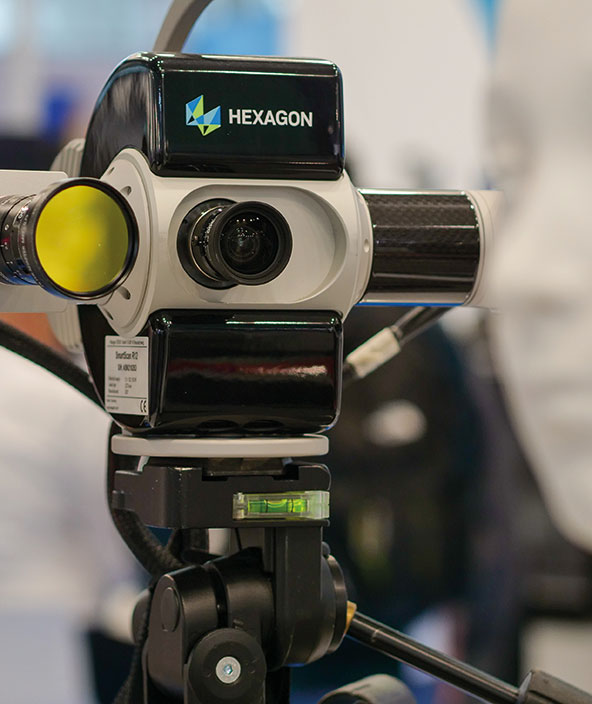Mold making in any dimension
Senckenberg Research Institute - Germany
Contact us
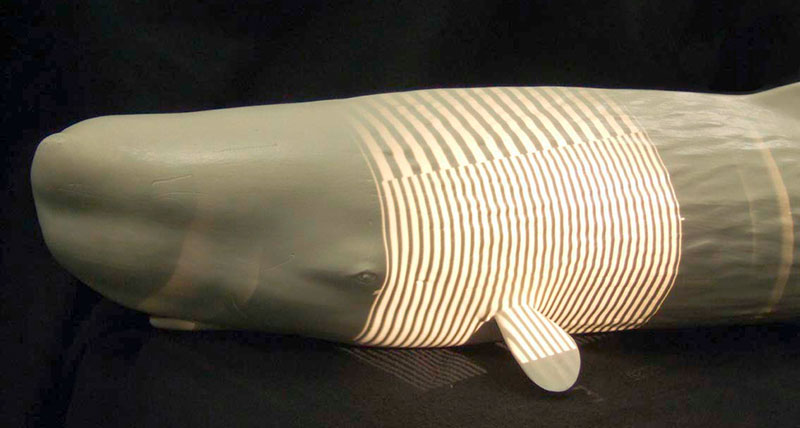
In order to manufacture authentic exhibition models for display in museums, a model maker does not only have to be technically very skilled but also has to have a good sense of imagination. When it comes to the task of creating a life-size, authentic replica of a sperm whale, in particular the dimensions of the model pose peculiar challenges to the execution. A project of the Senckenberg Research Institute and Natural History Museum Frankfurt (Germany) illustrates how such a challenge can be solved with the aid of an optical 3D scanning system.
Objective and measuring object
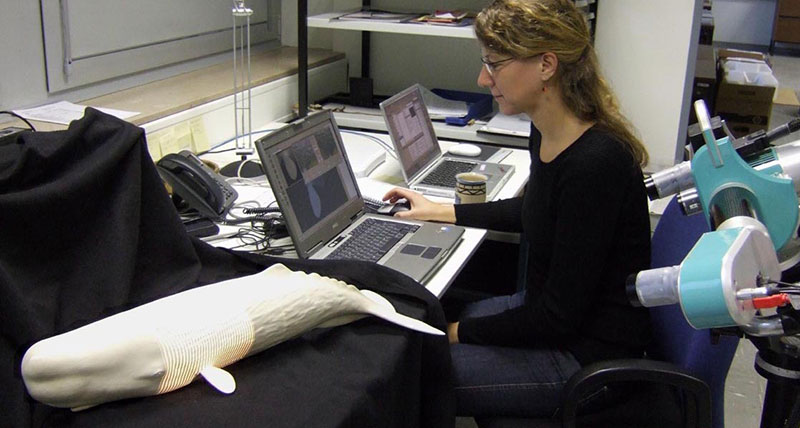 In October 2006, the model preparation department of the Senckenberg Research Institute and Natural History Museum has been assigned the unusual task to create a life-size replica of a sperm whale for the Senckenberg Deep Sea Exhibition, a project realised in cooperation with the Museum of Natural History Basel (Switzerland). At present, sperm whales are the largest living toothed whales. Adult female whales reach a length of up to 12.5 m, male adults grow even larger: at a body length of up to 20 m, they can weigh up to 57 tons.
In October 2006, the model preparation department of the Senckenberg Research Institute and Natural History Museum has been assigned the unusual task to create a life-size replica of a sperm whale for the Senckenberg Deep Sea Exhibition, a project realised in cooperation with the Museum of Natural History Basel (Switzerland). At present, sperm whales are the largest living toothed whales. Adult female whales reach a length of up to 12.5 m, male adults grow even larger: at a body length of up to 20 m, they can weigh up to 57 tons.
Members of staff at the Senckenberg Institute have opted to produce the sperm whale exhibition model by generating glass fibre-reinforced plastic compounds applying the free-form hand lay-up method. To do so, negative molds were milled from polyurethane blocks with the help of CNC technique. For this procedure, in a first step a micro model was created and then three-dimensionally digitised. In a subsequent step, the generated data was converted into NC data for the milling machine.
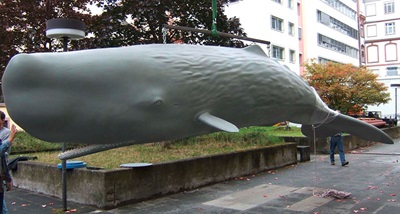 The sperm whale showcased at the Deep Sea Exhibition illustrates a three to four year old female pup measuring 7.5 m in length, which is why specific characteristics of the body frame had to be taken into account. In a first project step, Udo Becker, model maker at the Frankfurt Senckenberg Natural History Museum, created a downscaled 1:10 PVC model on the basis of photographs.
The sperm whale showcased at the Deep Sea Exhibition illustrates a three to four year old female pup measuring 7.5 m in length, which is why specific characteristics of the body frame had to be taken into account. In a first project step, Udo Becker, model maker at the Frankfurt Senckenberg Natural History Museum, created a downscaled 1:10 PVC model on the basis of photographs.
Measuring system and setup
The three-dimensional digital acquisition of this model is achieved with the aid of the 3D scanning system AICON SmartScan, a system which the Senckenberg Research Institute has been using for many years in numerous different types of projects. The AICON SmartScan operates on the basis of the patented miniaturized projection technique (MPT), which allows for scanning times of less than one second. Rather than capturing only individual points, the entire surface is being captured, enabling the rapid and precise measurement of even very complex object geometries or fragile and easily deformable structures.
Thanks to their modular design with black-and-white or colour cameras in various resolutions and configurations, the AICON SmartScan can be easily customised to the individual requirements of any type of digitisation project.
Workflow
The body of the sperm whale ‘mini’ model is being captured through approximately 20 individual shots with a measuring field of 240 x 180 mm. To capture the smaller details such as the fins and jaw, a smaller measuring field of 72 x 54 mm together with a threefold higher resolution is being used. Thanks to the flexible sensor configuration allowing scanning processes at triangulation angles of 30°, 20° and 10°, even very difficult object areas can be swiftly and precisely captured.
 In a subsequent step, the individual 3D measurements of the sperm whale model are converted into a final polygon mesh and exported in STL format by the software AICON OptoCat. The entire scanning time takes about half a working day; post-processing activities, such as filling-in holes and assembling the individual elements (body, fins and jaw area), take up another half a day.
In a subsequent step, the individual 3D measurements of the sperm whale model are converted into a final polygon mesh and exported in STL format by the software AICON OptoCat. The entire scanning time takes about half a working day; post-processing activities, such as filling-in holes and assembling the individual elements (body, fins and jaw area), take up another half a day.
The negative mold parts are milled out of PU block material. Applying the hand lay-up technique, a glass fiber reinforced plastic compound structure is gradually formed inside the open forms. After demolding, the two large positive fiber shapes are bonded together, followed by attaching the separately crafted fins as well as the teethed bottom jaw to the main body. Finally, the generically painted glass eyes are inserted and the surface of the sperm whale model is coloured with a special glaze. Following this described technique, a durable and sturdy exhibit in light weight construction is formed.
Conclusion
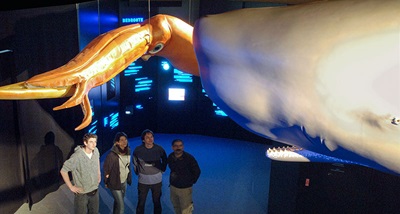 The model making department of the Senckenberg Museum produced a 7.5 meters long authentic replica of a sperm whale. The impressively sized exhibit was manufactured using GRP technique and negative molds. Basis for all working stages was a true-to-detail modeled template of the whale at a scale of 1:10. Using the AICON scanning system, this model was then three-dimensionally scanned, followed by further processing of the generated data with special software. In the final stage, the actual life-size model was created with the help of NC data and a CNC milling machine.
The model making department of the Senckenberg Museum produced a 7.5 meters long authentic replica of a sperm whale. The impressively sized exhibit was manufactured using GRP technique and negative molds. Basis for all working stages was a true-to-detail modeled template of the whale at a scale of 1:10. Using the AICON scanning system, this model was then three-dimensionally scanned, followed by further processing of the generated data with special software. In the final stage, the actual life-size model was created with the help of NC data and a CNC milling machine.
Thanks to the flexible and highly precise AICON scanner, the Senckenberg Natural History Museum was able to obtain the complete digital template for the modeling process of the real-size sperm whale. For these kinds of projects, the AICON SmartScan captures even irregular shapes at high speed and accuracy; the generated 3D data are the ideal basis for modeling the life-size, true-to-original replica.
We would like to express our appreciation to the members of staff at the Senckenberg Research Institute and Natural History Museum for their kind contribution of the photographic material and information to compile this report.
Literature
- Udo Becker (2008): Bau eines Pottwals mit GFK-Technik. ("Building a sperm whale using the GRP technique") In: Der Präparator (The Preparator), Ed.: Verband Deutscher Präparatoren e.V. Bremen (Association of German Preparators), 2008: 36-49.
- Christine Hemm-Herkner (2007): Einsatzmöglichkeiten von 3D-Scannern in der Paläontologie und deren Anwendung. (“Application possibilities of 3D scanning systems in the field of Palaeontology”) In: Der Präparator (The Preparator), Ed.: Verband Deutscher Präparatoren e.V. Bremen (Assosication of German Preparators), 2008: 24-28.
